Excerpts from Jim Conrad's
Naturalist Newsletter
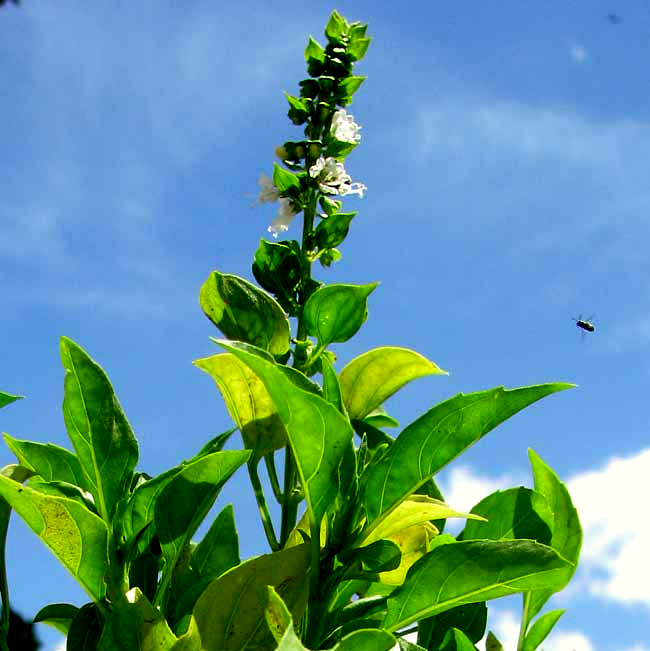
from the May 12, 2007 Newsletter Issued from Hacienda Chichen Resort adjoining Chichén Itzá Ruins in YUCATÁN, MÉXICO
BASIL FLOWERING
Basil, OCIMUM BASILICUM, the Basil in our garden also is flowering nowadays, as you can see above. That plant clearly isn't in the peak of health, for during the dry season, if something is on the watering list, gardeners tend to overwater, and that leaches nitrogen from the soil, which accounts for the yellowing leaves. Also, to have thick, succulent leaves for cooking you need to pinch off a plant's flowers, and two pairs of leaves under them. Flowering causes a hormone change in the plant dramatically reducing leaf growth as well as leaf pungency.
Anyway, in the above picture the plant is about knee high and a honeybee is approaching the white flowers, which are stacked in racemes at branch ends. A close-up showing a half-inch long flower (1.5 cm) is below:
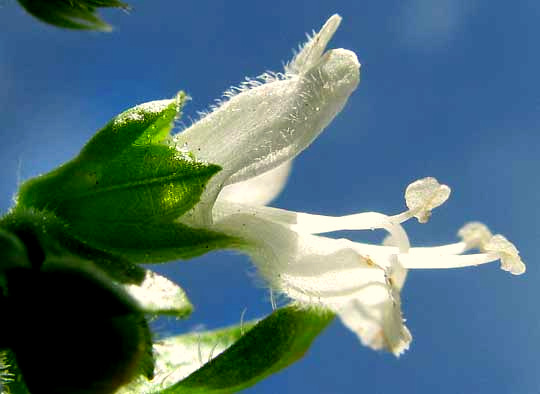
Basil is a member of the big, often good-smelling Mint Family, and the flower in the picture shows basic Mint-Family features. The green calyx is five-toothed. Both the calyx and white corolla are bilaterally symmetrical as opposed to being radially symmetrical like the above Rue flower (note the bottom lip being longer than the top). There are four stamens of two lengths.
One of the most interesting Mint-Family features, however, isn't seen unless you look inside a calyx from which the old corolla has fallen off, and the ovary has already matured somewhat. For, in the Mint Family, the ovary is very deeply "four-lobed." When the ovary matures, each lobe forms a "nutlet," so you get four little seed-like nutlets nestled in the calyx's bottom like eggs in a basket. You can see a calyx with one side removed so you can see the nutlets below:
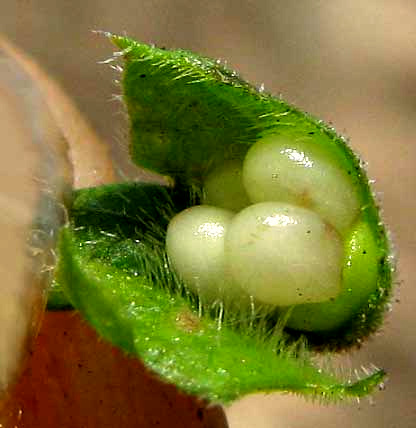
Again, those egglike things, the nutlets, are not seeds, but rather each is one part of a deeply four- lobed ovary. One seed resides inside each nutlet.
Basil's genus name, Basilicum, is from classical Greek meaning "kingly," because of Basil's healing properties. It's interesting that in the North we don't think of Basil as medicinal, but indigenous cultures often have a high regard for its medicinal value. Basil is native to the Old World Tropics, so it's been introduced into the pharmacopeias of New-World indigenous people since the European invasion.
And I can tell you that when I roll Rue leaves into a Basil leaf and poke the resulting little, green cigar into my fungusy ear awhile, my ear doesn't itch all night the way it does if I don't.
from the February 18, 2018 Newsletter issued from Rancho Regensis north of Valladolid, Yucatán, MÉXICO;
elevation ~40m (~130 ft), N~20.876°, W~88.170°
BASIL SURPRISE
Last October when Lee, the rancho owner, returned from her yearly visit with family and friends in Canada, she brought several bunches of seeds she'd informally collected here and there. In a wrapped-up napkin labeled with a ballpoint pen as Lavender she presented me some brown, crumbly material containing seeds. I planted them, but as soon as they came up they didn't look like Lavender. It was a mint, but what kind of mint was this? I wasn't for sure until it flowered, producing the plants pictured below, growing between rows of cardboard mulch:
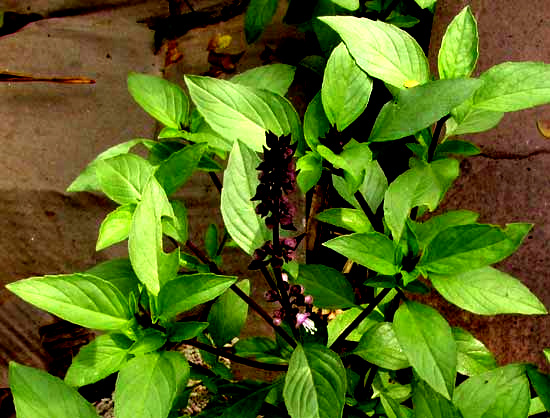
It looked like a basil cultivar, though it wasn't the typical garden one, nor to me did it smell like basil. So, how does know whether you have a basil or one of the 3000 or so other Mint Family species, some of which are basil-like?
Fist of all, the flowers are grouped at the tips of branches in spike-like racemes, a raceme being when each flower is attached to the main stem stem with a stalk, or "pedicel," as seen below:
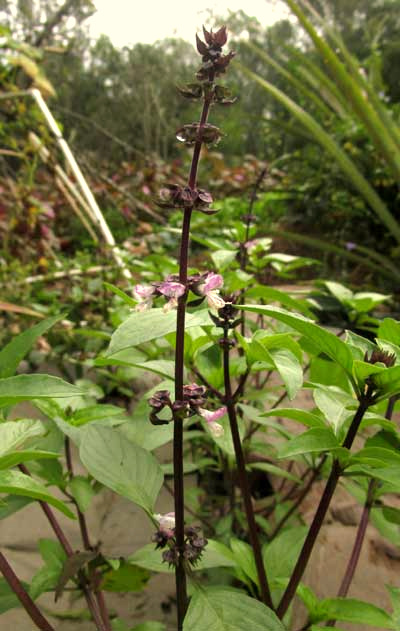
An important field mark shown in that picture is that the flower clusters, or whorls, are somewhat separated from one another. In many species producing branch-tip racemes, the whorls grow so close to one another that no main stem shows between them.
All else we need to know to be sure we have a basil is provided by the dew-drenched blossom shown below:

First, in that picture you can see that a flower whorl consists of six blossoms. Second, the corollas are two-lipped, as they should be for the Mint Family, plus the top lip is 4-lobed. Third, there are four stamens, of which the top pair is shorter than the bottom one. Finally, the top lip of the purple calyx from which the corolla arises is somewhat caplike, typical of the basils.
So, we have basil cultivar whose crushed leaves emit an unusual smell. However, between 50 and 150 types of basil are recognized, so we still don't have our plants pegged down completely. All basils are members of the genus Ocimum, and most but not all basil cultivars are Ocimum basilicum. Some culinary basils are members of other Ocimum species, and others are hybrids. You might enjoy looking over Wikipedia's page on basil cultivars.
Our cultivar displays several features different from those of the basil typically grown in North American gardens. For example, ours has smaller, more slender leaves, and the stems and all flower parts are deep purple or purple tinged.
By matching our plant's features with those of labeled cultivars on the Internet, it appears that our plants probably are Ocimum basilicum var. thyrsiflorum, often known as Thai Basil. Thai Basil is said to smell of licorice or anise, and some who have smelled our garden plant's leaves said that there's something licorice-like about their odor, but I can't see it. To me the odor is almost unpleasant, somehow oily smelling, and, in fact, somewhat like the fragrance of Lavender. I've searched for a basil cultivar smelling like Lavender, however, and find nothing.
So, now we have plenty of basil but we're not sure if the leaves will be useful in dishes. We'll just have to see if people like it.